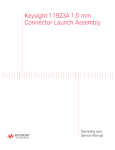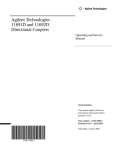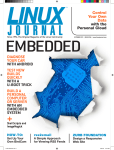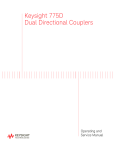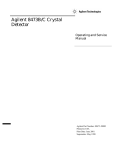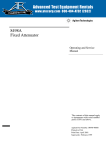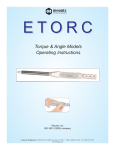Download 11923A 1.0 mm Connector Launch Assembly Operating and Service
Transcript
11923A 1.0 mm Connector Launch Assembly Operating and Service Manual Agilent Part Number: 11923-90001 Printed in USA February 2001 Supersedes: March 1999 Notice The information contained in this document is subject to change without notice. Agilent Technologies makes no warranty of any kind with regard to this material, including, but not limited to, the implied warranties of merchantability and fitness for a particular purpose. Agilent Technologies shall not be liable for errors contained herein or for incidental or consequential damages in connection with the furnishing, performance, or use of this material. Agilent Technologies assumes no responsibility for the use or reliability of its software on equipment that is not furnished by Agilent Technologies. This document contains proprietary information which is protected by copyright. All rights are reserved. No part of this document may be photocopied, reproduced, or translated to another language without prior written consent of Agilent Technologies. Restricted Rights Legend Use, duplication, or disclosure by the U.S. Government is subject to restrictions as set forth in subparagraph (c)(1)(ii) of the Rights in Technical Data and Computer Software clause at DFARS 252.227-7013 for DOD agencies, and subparagraphs (c)(1) and (c)(2) of the Commercial Computer Software Restricted Rights clause at FAR 52.227-19 for other agencies. Agilent Technologies, Inc Santa Rosa Systems Division 1400 Fountaingrove Parkway Santa Rosa, CA 95403-1799, U.S.A. © Copyright 1999, 2001 Agilent Technologies, Inc. ii Agilent Technologies 11923A Launch Assembly Operating and Service Manual Warranty Certification Agilent Technologies certifies that this product met its published specifications at the time of shipment from the factory. Agilent Technologies further certifies that its calibration measurements are traceable to the United States National Institute of Standards and Technology (NIST, formerly NBS), to the extent allowed by the Institute’s calibration facility, and to the calibration facilities of other International Standards Organization members. Warranty This Agilent Technologies system product is warranted against defects in materials and workmanship for a period corresponding to the individual warranty periods of its component products. Instruments are warranted for a period of one year. During the warranty period, Agilent Technologies will, at its option, either repair or replace products that prove to be defective. Warranty service for products installed by Agilent Technologies and certain other products designated by Agilent Technologies will be performed at Buyer’s facility at no charge within Agilent Technologies service travel areas. Outside Agilent Technologies service travel areas, warranty service will be performed at Buyer’s facility only upon Agilent Technologies’s prior agreement and Buyer shall pay Agilent Technologies’s round trip travel expenses. In all other areas, products must be returned to a service facility designated by Agilent Technologies. For products returned to Agilent Technologies for warranty service, Buyer shall prepay shipping charges to Agilent Technologies and Agilent Technologies shall pay shipping charges to return the product to Buyer. However, Buyer shall pay all shipping charges, duties, and taxes for products returned to Agilent Technologies from another country. Agilent Technologies warrants that its software and firmware designated by Agilent Technologies for use with an instrument will execute its programming instructions when properly installed on that instrument. Agilent Technologies does not warrant that the operation of the instrument, or software, or firmware will be uninterrupted or error free. LIMITATION OF WARRANTY. The foregoing warranty shall not apply to defects resulting from improper or inadequate maintenance by Buyer, Buyer-supplied software or interfacing, unauthorized modification or misuse, operation outside of the environmental specifications for the product, or improper site preparation or maintenance. Agilent Technologies 11923A Launch Assembly Operating and Service Manual iii NO OTHER WARRANTY IS EXPRESSED OR IMPLIED. AGILENT TECHNOLOGIES SPECIFICALLY DISCLAIMS THE IMPLIED WARRANTIES OR MERCHANTABILITY AND FITNESS FOR A PARTICULAR PURPOSE. EXCLUSIVE REMEDIES. THE REMEDIES PROVIDED HEREIN ARE BUYER’S SOLE AND EXCLUSIVE REMEDIES. AGILENT TECHNOLOGIES SHALL NOT BE LIABLE FOR ANY DIRECT, INDIRECT, SPECIAL, INCIDENTAL, OR CONSEQUENTIAL DAMAGES, WHETHER BASED ON CONTRACT, TORT, OR ANY OTHER LEGAL THEORY. Assistance Product maintenance agreements and other customer assistance agreements are available for Agilent Technologies products. For assistance, call your local Agilent Technologies Sales and Service Office (refer to “Agilent Technologies Sales and Service Offices” on page v.) iv Agilent Technologies 11923A Launch Assembly Operating and Service Manual Agilent Technologies Sales and Service Offices UNITED STATES Instrument Support Center Agilent Technologies (800) 403-0801 EUROPEAN FIELD OPERATIONS Headquarters Agilent Technologies S.A. 150, Route du Nant-d’Avril 1217 Meyrin 2/ Geneva Switzerland (41 22) 780.8111 France Agilent Technologies France 1 Avenue Du Canada Zone D’Activite De Courtaboeuf F-91947 Les Ulis Cedex France (33 1) 69 82 60 60 Germany Agilent Technologies GmbH Agilent Technologies Strasse 61352 Bad Homburg v.d.H Germany (49 6172) 16-0 Great Britain Agilent Technologies Ltd. Eskdale Road, Winnersh Triangle Wokingham, Berkshire RG41 5DZ England (44 118) 9696622 INTERCON FIELD OPERATIONS Headquarters Agilent Technologies Company 3495 Deer Creek Rd. Palo Alto, CA 94304-1316 USA (415) 857-5027 Australia Agilent Technologies Australia Ltd. 31-41 Joseph Street Blackburn, Victoria 3130 (61 3) 895-2895 Canada Agilent Technologies (Canada) Ltd. 17500 South Service Road Trans-Canada Highway Kirkland, Quebec H9J 2X8 Canada (514) 697-4232 Japan Agilent Technologies Japan, Ltd. Measurement Assistance Center 9-1, Takakura-Cho, Hachioji-Shi, Tokyo 192-8510, Japan TEL (81) -426-56-7832 FAX (81) -426-56-7840 Singapore Agilent Technologies Singapore (Pte.) Ltd. 150 Beach Road #29-00 Gateway West Singapore 0718 (65) 291-9088 Taiwan Agilent Technologies Taiwan 8th Floor, H-P Building 337 Fu Hsing North Road Taipei, Taiwan (886 2) 712-0404 China China Agilent Technologies 38 Bei San Huan X1 Road Shuang Yu Shu Hai Dian District Beijing, China (86 1) 256-6888 Agilent Technologies 11923A Launch Assembly Operating and Service Manual v Safety and Regulatory Information Safety and Regulatory Information Review this product and related documentation to familiarize yourself with safety markings and instructions before you operate the instrument. This product has been designed and tested in accordance with international standards. WARNING The WARNING notice denotes a hazard. It calls attention to a procedure, practice, or the like, that, if not correctly performed or adhered to, could result in personal injury. Do not proceed beyond a WARNING notice until the indicated conditions are fully understood and met. CAUTION The CAUTION notice denotes a hazard. It calls attention to an operating procedure, practice, or the like, which, if not correctly performed or adhered to, could result in damage to the product or loss of important data. Do not proceed beyond a CAUTION notice until the indicated conditions are fully understood and met. Instrument Markings ! When you see this symbol on your instrument, you should refer to the instrument’s instruction manual for important information. This symbol indicates hazardous voltages. The laser radiation symbol is marked on products that have a laser output. This symbol indicates that the instrument requires alternating current (ac) input. The CE mark is a registered trademark of the European Community. If it is accompanied by a year, it indicates the year the design was proven. The CSA mark is a registered trademark of the Canadian Standards Association. 1SM1-A This text indicates that the instrument is an Industrial Scientific and Medical Group 1 Class A product (CISPER 11, Clause 4). This symbol indicates that the power line switch is ON. This symbol indicates that the power line switch is OFF or in STANDBY position. vi Agilent Technologies 11923A Launch Assembly Operating and Service Manual Contents Notice . . . . . . . . . . . . . . . . . . . . . . . . . . . . . . . . . . . . . . . . . . . . . . . . . . . . . .ii Warranty . . . . . . . . . . . . . . . . . . . . . . . . . . . . . . . . . . . . . . . . . . . . . . . . . . . iii Certification . . . . . . . . . . . . . . . . . . . . . . . . . . . . . . . . . . . . . . . . . . . . . iii Warranty . . . . . . . . . . . . . . . . . . . . . . . . . . . . . . . . . . . . . . . . . . . . . . . . iii Assistance . . . . . . . . . . . . . . . . . . . . . . . . . . . . . . . . . . . . . . . . . . . . . . . iv Agilent Technologies Sales and Service Offices . . . . . . . . . . . . . . . . . v Safety and Regulatory Information . . . . . . . . . . . . . . . . . . . . . . . . . . . . . . . vi 1. General Information Connector Launch Overview . . . . . . . . . . . . . . . . . . . . . . . . . . . . . . . . . . 1-1 Serial Numbers . . . . . . . . . . . . . . . . . . . . . . . . . . . . . . . . . . . . . . . . . . 1-1 Incoming Inspection . . . . . . . . . . . . . . . . . . . . . . . . . . . . . . . . . . . . . . 1-2 Clarifying Connector Sex . . . . . . . . . . . . . . . . . . . . . . . . . . . . . . . . . . 1-2 Figure 1-1. Male and Female Connectors . . . . . . . . . . . . . . . . . . . . 1-2 2. Specifications Electrical Specifications . . . . . . . . . . . . . . . . . . . . . . . . . . . . . . . . . . . . . . 2-1 Supplemental Characteristics . . . . . . . . . . . . . . . . . . . . . . . . . . . . . . . . . . 2-1 Table 2-1. Electrical Specifications . . . . . . . . . . . . . . . . . . . . . . . . . . 2-1 Table 2-2. Supplemental Electrical Characteristics . . . . . . . . . . . . . 2-1 Table 2-3. Supplemental Mechanical Characteristics . . . . . . . . . . . . 2-2 Environmental Requirements . . . . . . . . . . . . . . . . . . . . . . . . . . . . . . . . . . 2-3 Table 2-4. Environmental Requirements . . . . . . . . . . . . . . . . . . . . . . 2-3 Temperature—What To Watch Out For . . . . . . . . . . . . . . . . . . . . . . . 2-3 3. Mounting the Launch Creating the Package or Fixture Wall . . . . . . . . . . . . . . . . . . . . . . . . . 3-1 Figure 3-1. Section View of Machining Detail for the Package Wall 3-1 Threading the Launch into the Package or Fixture . . . . . . . . . . . . . . 3-2 Mounting the Circuit Inside the Package . . . . . . . . . . . . . . . . . . . . . . 3-2 Figure 3-2. Circuit Mounting Detail . . . . . . . . . . . . . . . . . . . . . . . . . 3-3 4. Making Connections Electrostatic Discharge . . . . . . . . . . . . . . . . . . . . . . . . . . . . . . . . . . . . 4-1 Preventive Maintenance . . . . . . . . . . . . . . . . . . . . . . . . . . . . . . . . . . . 4-1 Visual Inspection . . . . . . . . . . . . . . . . . . . . . . . . . . . . . . . . . . . . . . . . . . . 4-2 Required Inspection Tools . . . . . . . . . . . . . . . . . . . . . . . . . . . . . . . . . 4-2 Obvious Defects or Damage . . . . . . . . . . . . . . . . . . . . . . . . . . . . . . . . 4-2 Connector Contacts . . . . . . . . . . . . . . . . . . . . . . . . . . . . . . . . . . . . . . 4-3 Figure 4-1. Contact Integrity . . . . . . . . . . . . . . . . . . . . . . . . . . . . . . 4-3 Concentricity . . . . . . . . . . . . . . . . . . . . . . . . . . . . . . . . . . . . . . . . . . . 4-3 Figure 4-2. Concentricity - Female Connector . . . . . . . . . . . . . . . . 4-3 Agilent Technologies 11923A Launch Assembly Operating and Service Manual Contents 1 Figure 4-3. Concentricity - Male Connector . . . . . . . . . . . . . . . . . . 4-4 Mating Plane Surfaces . . . . . . . . . . . . . . . . . . . . . . . . . . . . . . . . . . . 4-4 Damaged Connectors . . . . . . . . . . . . . . . . . . . . . . . . . . . . . . . . . . . . 4-4 Connector Wear . . . . . . . . . . . . . . . . . . . . . . . . . . . . . . . . . . . . . . . . . 4-4 Pin Depth . . . . . . . . . . . . . . . . . . . . . . . . . . . . . . . . . . . . . . . . . . . . . . . . . 4-5 Protrusion and Recession . . . . . . . . . . . . . . . . . . . . . . . . . . . . . . . . . 4-5 Figure 4-4. Connector Pin Depth . . . . . . . . . . . . . . . . . . . . . . . . . . 4-5 Connector Alignment . . . . . . . . . . . . . . . . . . . . . . . . . . . . . . . . . . . . . . . 4-6 Figure 4-5. Alignment . . . . . . . . . . . . . . . . . . . . . . . . . . . . . . . . . . 4-7 Connector Misalignment . . . . . . . . . . . . . . . . . . . . . . . . . . . . . . . . . . 4-7 Figure 4-6. Forced Misalignment . . . . . . . . . . . . . . . . . . . . . . . . . . 4-7 Cleaning Connectors . . . . . . . . . . . . . . . . . . . . . . . . . . . . . . . . . . . . . . . . 4-8 Supplies and Equipment Needed . . . . . . . . . . . . . . . . . . . . . . . . . . . 4-8 Basic Cleaning Procedure . . . . . . . . . . . . . . . . . . . . . . . . . . . . . . . . . 4-8 Figure 4-7. Cleaning Illustration . . . . . . . . . . . . . . . . . . . . . . . . . . 4-8 Connection Procedure . . . . . . . . . . . . . . . . . . . . . . . . . . . . . . . . . . . . . . . 4-9 Connection Procedure . . . . . . . . . . . . . . . . . . . . . . . . . . . . . . . . . . . . 4-9 Using the Torque Wrench . . . . . . . . . . . . . . . . . . . . . . . . . . . . . . . . . . . 4-10 Required Wrenches . . . . . . . . . . . . . . . . . . . . . . . . . . . . . . . . . . . . . 4-10 Table 4-1. Torque Wrench Information . . . . . . . . . . . . . . . . . . . . 4-10 Torque Wrench Procedure . . . . . . . . . . . . . . . . . . . . . . . . . . . . . . . . 4-10 Disconnection Procedure . . . . . . . . . . . . . . . . . . . . . . . . . . . . . . . . . . . . 4-11 Handling and Storage . . . . . . . . . . . . . . . . . . . . . . . . . . . . . . . . . . . . . . 4-12 5. Replaceable Parts Table 5-1. Replaceable Parts . . . . . . . . . . . . . . . . . . . . . . . . . . . . . . 5-1 Contents 2 Agilent Technologies 11923A Launch Assembly Operating and Service Manual 1 General Information Connector Launch Overview The 11923A 1.0-mm female connector launch assembly is designed for ultra-high frequency (up to 110 GHz) coaxial signal transmission into a microstrip package. The launch assembly facilitates designing, building, testing, and troubleshooting high-frequency microcircuits, components, and custom prototypes. The launch assembly threads into a package or fixture housing. The user is responsible for the machining of the package and installing the launch into the package. Procedures describing the necessary geometry for machining the package wall and instructions for mounting the launch are given in Chapter 3. The launch assembly features a 1.0-mm female connector on one end and a gold-plated pin interface to the microcircuit on the other. Serial Numbers • The 1.0-mm center conductor is supported by a low-loss plastic bead. The connector interface utilizes an air dielectric for the highest accuracy and repeatability, and is designed to meet or exceed the IEE Std 287 Precision Coaxial Connector GPC grade specifications. • The launch assembly contains a glass-to-metal seal soldered inside the launch housing. The gold-plated pin on the launch extends inside the package or fixture for connection onto the circuit. A serial number label is attached to the foam-lined box containing the launch. The serial number is made up of five numbers and is unique to each adapter. Agilent Technologies 11923A Launch Assembly Operating and Service Manual 1-1 General Information Incoming Inspection Clarifying Connector Sex Agilent Technologies will arrange for repair or replacement of incomplete or damaged shipments without waiting for a settlement from the transportation company. When you send a device to Agilent Technologies, include the following information: • • Your company name and address. • If you are returning one or more devices, include the part numbers and serial numbers. • • Indicate the type of service required. A technical contact person within your company, and the person’s complete phone number. Include any applicable information. In this manual, connectors are referred to in terms of their device sex. Male Connector Female Connector Figure 1-1 Male and Female Connectors 1-2 Agilent Technologies 11923A Launch Assembly Operating and Service Manual 2 Specifications Electrical Specifications Electrical specifications are performance standards or limits against which the launch assemblies are tested. Table 2-1 Electrical Specifications Insertion loss Frequency Value dc to 110 GHz –1.0 dB Supplemental Characteristics Supplemental characteristics are values which are typically met by the majority of the launches tested at agilent Technologies. These supplemental characteristics are intended to provide useful information. They are typical but non-warranted performance parameters. Center Conductor Protrusion and Pin Depth The supplemental mechanical characteristics such as center conductor protrusion and pin depth are important supplemental characteristics related to electrical performance. Pin depth is measured mechanically and verified by electrical testing. This ensures that the 1.0-mm connector does not exhibit any center conductor protrusion and has proper pin depth when it leaves the factory. Table 2-2 Supplemental Electrical Characteristics Characteristic Frequency Typical Value Return loss dc to 110 GHz –16 dB Maximum power dc to 110 GHz 6W Agilent Technologies 11923A Launch Assembly Operating and Service Manual 2-1 Specifications Reference Plane to Reference Plane Table 2-3 Supplemental Mechanical Characteristics Characteristic Typical Value Inside diameter of 1.0-mm outer conductor 1.000 ± 0.005 mm Outside diameter of center conductor 0.434 ± 0.005 mm Length of outer conductors1 10.34 mm (nominal) Inside diameter of launch body feedthru 0.38 ± 0.010 mm Outside diameter of launch pin 0.162 ± 0.005 mm 1.0-mm female connector pin depth 0 (flush) to 0.025 mm (maximum recession) Launch pin extension 0.32 ± 0.05 mm Flatness of reference plane 0.010 mm (worst case) Flatness of end of launch body 0.010 mm (worst case) 1. Reference place to reference plane 2-2 Agilent Technologies 11923A Launch Assembly Operating and Service Manual Specifications Environmental Requirements Table 2-4 Environmental Requirements Parameter Required Values/Ranges Operating temperature 0 to 55 °C (32 tο 131 °F) Storage temperature –40 to +75 °C (–40 to +167 °F) Altitude Operation Storage < 15,000 meters (≈ 50,000 feet) < 15,000 meters (≈ 50,000 feet) Relative humidity Operation Storage Always non-condensing 0 to 80% (26 °C maximum dry bulb) 0 to 90% Temperature—What To Watch Out For Due to the critical dimensions and tight tolerances of the 1.0-mm connector, electrical characteristics will change with temperature. The operating temperature is a critical factor in the performance during measurements and between calibrations. CAUTION Remember your fingers are a heat source, so avoid handling the devices unnecessarily. Agilent Technologies 11923A Launch Assembly Operating and Service Manual 2-3 3 Mounting the Launch Creating the Package or Fixture Wall The launch is designed to be threaded into a 5-mm thick package wall. The user is responsible for machining the package and installing the launch. Figure 3-1 shows the machining detail for creating the package wall. 5.0 0.05 M7 x 0.75 6H Centerline Offset -A4.50 0.01 3.2 Min 5.15 1.65 0.10 0.05 0.01 A S Figure 3-1 Section View of Machining Detail for the Package Wall The following machining details are recommended to provide optimum connections. All measurements are in millimeters (mm). • • The bottom of the 4.50 diameter hole must be flat for proper grounding. • The centerline offset between the threaded and the package floor is calculated as follows: The edge between the package floor and the 4.50 diameter hole must be carefully deburred with a minimum corner break. Offset = substrate thickness + 0.081 (radius of pin) + 0.075 (clearance for solder flow) • Gold plating is recommended for conductivity and corrosion protection. Agilent Technologies 11923A Launch Assembly Operating and Service Manual 3-1 Mounting the Launch Threading the Launch into the Package or Fixture If you need a quasi-hermetic seal or you want to permanently retain the launch assembly in the package or fixture, epoxy may be applied to the threads of the launch prior to installation. Use heat to cure the epoxy, if necessary. CAUTION Do not overheat. The dielectric material in the support bead is capable of withstanding 125 °C for prolonged periods and 150 °C for short periods. 1. Hand thread the launch all the way into the package or fixture wall and then reverse thread 1/8 turn or 45 degrees of rotation to allow for final tightening with a torque wrench. 2. Use a 7-mm torque wrench* on the hex portion of the launch body to thread it into the package wall. Tighten the launch into the package with 56 N-cm (5 in-lb) of torque. Refer to “Using the Torque Wrench” on page 4-10 for the recommended procedure. This is enough to create a slight deformation where the launch contacts the package floor to assure a good ground connection. * This torque wrench is not available from Agilent Technologies. Refer to Table 5-1 for supplier information. Mounting the Circuit Inside the Package 1. Clean all surfaces with alcohol and blow them dry with filtered compressed air. 2. For the best match, place the edge of the circuit 0.022 ± 0.008 mm from the end of the outer body of the launch. Refer to Figure 3-2. 3. Slide the circuit under the launch pin. Align it so that the launch pin is directly over the signal trace. 4. Affix the circuit to the package body with electrically conductive epoxy. CAUTION Do not overheat. The dielectric material in the support bead is capable of withstanding 125 °C for prolonged periods and 150 °C for short periods. 3-2 Agilent Technologies 11923A Launch Assembly Operating and Service Manual Mounting the Launch 5. Complete the signal path by soldering the launch pin to the signal trace. OR Complete the signal path by gold ribbon bond attachment. For best performance, size the gold ribbon to match the dimensions of the launch pin and the signal trace. NOTE If solder is used, it is important to control the volume of the solder flow to match the size of the launch pin and the signal trace. Be careful to avoid too much solder (capacitive) or too little (inductive). Side View End View Package Wall Launch Body Launch Pin Solder Circuit Solder Ground Plane 0.022 ± 0.008 Figure 3-2 Signal Trace Circuit Mounting Detail Agilent Technologies 11923A Launch Assembly Operating and Service Manual 3-3 4 Making Connections Electrostatic Discharge Protection against ESD (electrostatic discharge) is essential while cleaning, inspecting, or connecting any connector attached to a static–sensitive circuit (such as those found in test sets). Static electricity builds up on the body, and can easily damage sensitive internal circuit elements when discharged by contact with the center conductor of a connector. Static discharges too small to be felt can cause permanent damage. Devices such as calibration and verification components, and devices under test can also carry an electrostatic charge. Preventive Maintenance • Always have a grounded antistatic mat in front of your test equipment and wear a grounded wrist strap attached to it. • Ground yourself before you clean, inspect, or make a connection to a static–sensitive device or test port. You can, for example, grasp the grounded outer shell of the test port briefly to discharge static from your body. • Discharge static electricity from a device before connecting it. Touch the device briefly (through a resistor of at least 1 M Ω) to either the outer shell of the test port, or to another exposed ground. This discharges static electricity and protects test equipment circuitry. The best techniques for maintaining the integrity of 1.0-mm connectors is to include routine visual inspection (using 10X magnification), cleaning, and proper connection techniques using the procedures in the following sections. Failure to detect and remove dirt or metallic particles on a mating plane surface can degrade repeatability and accuracy, and can damage any connector mated to it. Improper connections resulting from poor connection techniques can also damage these devices. Connector cleaning supplies and electrostatic discharge safety supplies are not provided but can be ordered separately. For cleaning and inspection, a 10X magnifying glass is available. (Refer to Chapter 5, “Replaceable Parts” for ordering information.) Agilent Technologies 11923A Launch Assembly Operating and Service Manual 4-1 Making Connections Visual Inspection Visual Inspection Visual inspection, and if necessary, cleaning should be done every time a connection is made. Metal particles from the connector threads may fall into the connector when it is disconnected. One connection made with a dirty or damaged connector can damage both connectors beyond repair. Required Inspection Tools A minimum magnification of 10X is required to inspect the mating surfaces, connector contacts, and concentricity of the 1.0-mm connectors. It is also necessary to use good lighting (such as a halogen task light) to see the damage on a connector. Use the guidelines in “Obvious Defects or Damage” when evaluating the integrity of your connectors. Obvious Defects or Damage Examine the connectors first for obvious defects or damage: • Plating ▲ ▲ • • Bare metal showing Burrs or blisters Deformed threads Center Conductors ▲ ▲ ▲ ▲ Bent Broken Misaligned Concentricity Connector nuts should move smoothly and be free of: ▲ ▲ ▲ Burrs Loose metal particles Rough spots Any connector that has obvious defects should be discarded. See Figure 4-1, Figure 4-2, and Figure 4-3 for visual inspection guidelines. 4-2 Agilent Technologies 11923A Launch Assembly Operating and Service Manual Making Connections Visual Inspection Connector Contacts Refer to Figure 4-1 for visual guidelines to aid you in evaluating the contact integrity of a connector. Take careful note of the location of the cross hairs in relationship to the center of the following figures. Perfectly formed, new contact Normal wear will spread contact slightly Damaged contact will look electrically capacitive Figure 4-1 Contact Integrity Concentricity Perfectly concentric Figure 4-2 and Figure 4-3 show the concentricity of both the male and female 1.0-mm connectors. .025 mm off-center specification maximum >.025 mm off-center DO NOT USE Figure 4-2 Concentricity - Female Connector Agilent Technologies 11923A Launch Assembly Operating and Service Manual 4-3 Making Connections Visual Inspection .025 mm off-center specification maximum Perfectly concentric Figure 4-3 Mating Plane Surfaces > .025 mm off-center DO NOT USE Concentricity - Male Connector Flat contact between the connectors at all points on their mating plane surface is required for a good connections. Look for deep scratches or dents, and for dirt and metal particles on the connector mating plane surfaces. Also look for “dings” on the mating plane surfaces of the center and outer conductors, and for signs of damage due to misalignment and excessive or uneven wear. A light burnishing of the mating plane surface is normal. This is evident as light scratches, or shallow circular marks distributed more or less uniformly over the mating plane surface. Other small defects and cosmetic imperfections are also normal. None of these affect electrical or mechanical performance. Clean and inspect the connector again if it shows: • • • Deep scratches or dents Particles clinging to the mating plane surface Uneven wear Damaged Connectors Before you connect a new, undamaged connector in the same configuration, try to determine the cause of the damaged connector to eliminate other connector problems. Damaged connectors should be discarded. Connector Wear Connector wear eventually degrades performance. The more use a connector gets, the faster it wears and degrades. The wear is greatly accelerated when connectors are not kept clean. When your connectors become worn, replace them. 4-4 Agilent Technologies 11923A Launch Assembly Operating and Service Manual Making Connections Pin Depth Pin Depth Pin depth is the distance that the center conductor mating plane differs from being flush with the outer conductor mating plane. The pin depth of a connector can be in one of two states, either protruding or recessed. Protrusion and Recession • NOTE At no time should the pin depth of the 1.0 mm connector be protruding. • Protrusion - the center conductor extends beyond the outer conductor mating plane. Recession - the center conductor is set back from the outer conductor mating plane. The pin depth value of each connector was verified to be within factory specifications at shipment. The electrical performance of the connector depends, to some extent, on its pin depth. The electrical specifications take into account the effect of pin depth on the performance of the connector. Figure 4-4 shows a visual representation of proper pin depth (slightly recessed). Male Female Outer Conductor Center Conductor Male Pin Depth Outer Conductor Mating Plane Female Pin Depth Outer Conductor Mating Plane Figure 4-4 Connector Pin Depth Agilent Technologies 11923A Launch Assembly Operating and Service Manual 4-5 Making Connections Connector Alignment Connector Alignment Good connections require a skilled operator. Instrument sensitivity and coaxial connector mechanical tolerances are such that slight errors in operator technique can have a significant effect on measurements and measurement uncertainties. NOTE The most common cause of measurement error is poor connections. Follow these recommendations for optimum connection technique: 1. Clean and inspect (visually and mechanically) all of your connectors. 2. Carefully align the connectors. Look for flat physical contact at all points on the mating plane surfaces. NOTE If one of the 1.0-mm connectors is free to move, self-alignment is possible during connection. Self-alignment occurs because outer conductors engage before the center conductors (refer to Figure 4-5 and Figure 4-6). 3. Make a gentle, preliminary connection. 4. When making a connection, turn only the connector nut. Do not rotate a device when you make a connection, and do not apply a lateral or horizontal (bending) force. 5. Use an open–end wrench to keep the device from rotating when you make a final connection with the torque wrench. 4-6 Agilent Technologies 11923A Launch Assembly Operating and Service Manual Making Connections Connector Alignment Figure 4-5 Alignment Connector Misalignment Forced misalignment could damage the female center conductor. Figure 4-6 Forced Misalignment NOTE To achieve misalignment as shown in Figure 4-6 you must use excessive force. Agilent Technologies 11923A Launch Assembly Operating and Service Manual 4-7 Making Connections Cleaning Connectors Cleaning Connectors Supplies and Equipment Needed The supplies and equipment that are needed to perform the cleaning procedures, and their Agilent Technologies part numbers are listed in Table 5-1 on page 5-1. NOTE A minimum magnification of 10X is required for all inspections of the 1.0-mm connector parts. Basic Cleaning Procedure 1. Inspect the connector for dust, dirt, metal fragments, oils or films, and debris. 2. Blow off any dust with a filtered, clean supply of compressed air. 3. Add a few drops of high-purity isopropyl alcohol to small cleaning swab (do not apply alcohol directly to the parts). NOTE When using isopropyl alcohol to clean connectors do not allow liquid to flow down inside the connector. This may cause measurement errors due to residue inside the connector. If possible keep the connector facing down. 4. Gently wipe connecting surfaces with the end of the cleaning swab (refer to Figure 4-7). 5. Blow dry with a clean supply of compressed air. 6. Inspect and repeat cleaning procedure if necessary. Figure 4-7 Cleaning Illustration 4-8 Agilent Technologies 11923A Launch Assembly Operating and Service Manual Making Connections Connection Procedure Connection Procedure Connection Procedure 1. Ground yourself and all devices (wear a grounded wrist strap and work on an antistatic mat). 2. Visually inspect the connectors (refer to “Visual Inspection” on page 4-2). 3. If necessary, clean the connectors (refer to “Cleaning Connectors” on page 4-8). 4. Carefully align the connectors. The male connector center pin must slip concentrically into the contact fingers of the female connector (refer to Figure 4-5 and Figure 4-6). 5. Push the connectors straight together. Do not twist or screw them together. As the center conductors mate, there is usually a slight resistance. CAUTION Do not twist one connector into the other (like inserting a light bulb). This happens when you turn the device body, rather than the connector nut. Major damage to the center conductor and the outer conductor can occur if the device body is twisted. 6. Initial tightening can be done by hand, or with an open-end wrench. Tighten until “snug” or where the connectors are first making contact. The preliminary connection is tight enough when the mating plane surfaces make uniform, light contact. Do not overtighten this connection. At this point, all you want is for the outer conductors to make gentle contact on both mating surfaces. Use very light finger pressure (no more than 2 in-lbs of torque). 7. Relieve any side pressure on the connection from long or heavy devices or cables. This assures consistent torque (refer to “Using the Torque Wrench” on page 4-10). Agilent Technologies 11923A Launch Assembly Operating and Service Manual 4-9 Making Connections Using the Torque Wrench Using the Torque Wrench Using the torque wrench guarantees that a connection is not too tight. This will help prevent possible connector damage. It also guarantees that all connections are equally tight each time. CAUTION 1. Static friction must not be present during torquing. 2. Do not pre-tighten so much that there is no rotation of the nut with the torque wrench. Leave about 1/8 turn or 45 degrees of rotation for the final tightening with the torque wrench. 3. Rotate only the connector nut when you tighten the connector. Use an open–end wrench to keep the body of the device from turning. Required Wrenches Table 4-1 provides information on the torque wrench required for making 1.0-mm connections and for the threading the launch into the package wall. Refer to Table 5-1 on page 5-1 for ordering information and part numbers. Table 4-1 Torque Wrench Information Torque Wrench Procedure Connector Type Torque Setting Torque Tolerance 1.0 mm 45 N–cm (4 in–lb) ±5.4 N–cm (±0.5 in–lb) Launch installation 56 N–cm (5 in–lb) ±5.4 N–cm (±0.5 in–lb) Backup Wrench 6 mm/7 mm • To thread the launch into the package wall, use a 7-mm torque wrench on the hex portion of the launch and tighten the launch into the package wall with 56 N-cm (5 in-lb) of torque. • To make 1.0-mm connections to the launch, use a 6-mm torque wrench to apply the recommended torque to the 1.0-mm male nut while holding the hex portion of the launch with a 7-mm open-end backup wrench. • To make other 1.0-mm connections, use a 6-mm torque wrench and 6-mm backup wrench (refer to “Connection Procedure” on page 4-9). 4-10 Agilent Technologies 11923A Launch Assembly Operating and Service Manual Making Connections Disconnection Procedure Disconnection Procedure To avoid lateral (bending) force on the connector mating plane surfaces, always support the devices and connections. 1. Use an open–end wrench to prevent the device body from turning. 2. Use another wrench to loosen the connector nut. 3. Complete the disconnection by hand, turning only the connector nut. CAUTION Do not twist one connector out of the other, (like removing a light bulb). Turn the connector nut, not the device body. Major damage to the center conductor and the outer conductor can occur if the device body is twisted. 4. Pull the connectors straight apart without twisting or bending. Agilent Technologies 11923A Launch Assembly Operating and Service Manual 4-11 Making Connections Handling and Storage Handling and Storage • Store the connector launch assembly in the original foam–lined box which has the serial number label attached to it. • Never store the assembly loose in a box, in a desk, or in a bench drawer. This is the most common cause of connector damage during storage. • • Keep connectors clean. • Do not set connectors contact–end down on a hard surface. The plating and the mating plane surfaces can be damaged if the interface comes in contact with any hard surface. Do not touch mating plane surfaces. Natural skin oils and microscopic particles of dirt are easily transferred to the connector interface and are very difficult to remove. 4-12 Agilent Technologies 11923A Launch Assembly Operating and Service Manual Replaceable Parts 5 Replaceable Parts NOTE There are no internal replaceable parts within the launch. The 1.0-mm connector is not considered field repairable. If a unit is in need of repair, a replacement must be purchased. The following table lists the part numbers necessary for inspection, connection, and ESD protection. To order a listed part, note the description, part number, and the quantity desired. Telephone or send your order to the nearest Agilent Technologies sales and service office listed in page -v. Table 5-1 Replaceable Parts Description Part Number Items Included With Launch Operating and Service Manual 11923-90001 Items Not Included With Launch 10X magnifying glass 1000–1114 6-mm 4 in-lb torque wrench 8710–2079 6-mm open-end wrench 8710–2156 7-mm 5 in-lb torque wrench TB OE 7-mm 5lbf-in1 7-mm open-end wrench 8710–1761 Cleaning swabs 9300–1745 Isopropyl alcohol (30 ml) 8500–5344 Grounding wrist strap 9300–1367 5-foot grounding cord (for wrist strap) 9300–0980 2 x 4 foot conductive table mat and 15-ft ground wire 9300–0797 ESD heel strap (for conductive floors) 9300–1126 1. Not available from Agilent Technologies. This part number may be ordered from Mountz, San Jose, CA. Agilent Technologies 11923A Launch Assembly Operating and Service Manual 5-1 Index A H assembling the package wall, 3-1 handling and storage, 4-12 C I center conductor protrusion and pin depth, 2-1 characteristics supplemental mechanical, 2-1 completing the signal path, 3-3 connections alignment, 4-6 process, 4-9 connector contacts, 4-3 connectors clarifying sex, 1-2 cleaning, 4-8 damaged, 4-4 defects or damage, 4-2 mating plane surface, 4-4 insertion loss, 2-1 inspection incoming, 1-2 visual, 4-2 L launch creating the package wall, 3-1 overview, 1-1 M maintenance, preventive, 4-1 making connections, 4-1 mating plane surfaces, 4-4 mounting the circuit, 3-2 mounting the launch, 3-1 D damaged connectors, 4-4 disconnection procedure, 4-11 P E electrostatic discharge, 4-1 environmental requirements, 2-1 F figure adapter dimensions, 2-1 alignment, 4-7 circuit mounting detail, 3-3 cleaning illustration, 4-8 concentricity female connector, 4-3 concentricity male connector, 4-4 connector pin depth, 4-5 contact integrity, 4-3 machining detail for mounting the launch, 3-1 male and female connectors, 1-2 misalignment, 4-7 package wall assembly instructions, 3-1 machining detail, 3-1 parts, replacing, 5-1 pin depth protrusion, 4-5 recession, 4-5 visual, 4-5 R repeatability, 2-1 replaceable parts, 5-1 return loss, 2-1 S serial numbers, 1-1 specifications, 2-1 electrical, 2-1 Agilent Technologies 11923A Launchy Assembly Operating and Service Manual Index 1 T temperature, operating, 2-1 torque wrench procedure for using, 4-10 settings and tolerance, 4-10 V visual inspection concentricity, 4-3 connector wear, 4-4 contact integrity, 4-3 mating plane surfaces, 4-4 obvious defects or damage, 4-2 required tools, 4-2 Index 2 Agilent Technologies 11923A Launchy Assembly Operating and Service Manual































